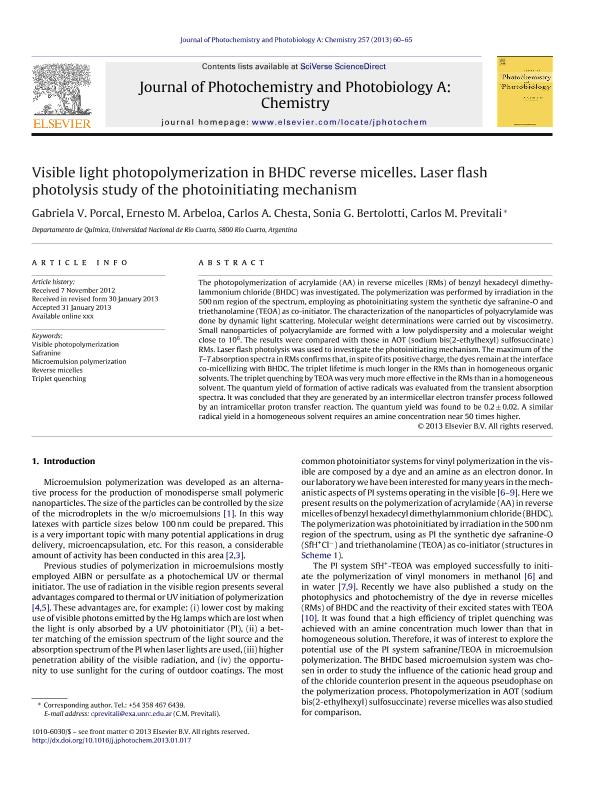Artículo
Visible light photopolymerization in BHDC reverse micelles: laser flash photolysis study of the photoinitiating mechanism
Porcal, Gabriela Valeria ; Arbeloa, Ernesto Maximiliano
; Arbeloa, Ernesto Maximiliano ; Chesta, Carlos Alberto
; Chesta, Carlos Alberto ; Bertolotti, Sonia Graciela
; Bertolotti, Sonia Graciela ; Previtali, Carlos Mario
; Previtali, Carlos Mario
 ; Arbeloa, Ernesto Maximiliano
; Arbeloa, Ernesto Maximiliano ; Chesta, Carlos Alberto
; Chesta, Carlos Alberto ; Bertolotti, Sonia Graciela
; Bertolotti, Sonia Graciela ; Previtali, Carlos Mario
; Previtali, Carlos Mario
Fecha de publicación:
02/2013
Editorial:
Elsevier Science
Revista:
Journal of Photochemistry and Photobiology A: Chemistry
ISSN:
1010-6030
Idioma:
Inglés
Tipo de recurso:
Artículo publicado
Clasificación temática:
Resumen
The photopolymerization of acrylamide (AA) in reverse micelles (RMs) of benzyl hexadecyl dimethylammonium chloride (BHDC) was investigated. The polymerization was performed by irradiation in the 500 nm region of the spectrum, employing as photoinitiating system the synthetic dye safranine-O and triethanolamine (TEOA) as co-initiator. The characterization of the nanoparticles of polyacrylamide was done by dynamic light scattering. Molecular weight determinations were carried out by viscosimetry. Small nanoparticles of polyacrylamide are formed with a low polydispersity and a molecular weight close to 106. The results were compared with those in AOT (sodium bis(2-ethylhexyl) sulfosuccinate) RMs. Laser flash photolysis was used to investigate the photoinitiating mechanism. The maximum of the T–T absorption spectra in RMs confirms that, in spite of its positive charge, the dyes remain at the interface co-micellizing with BHDC. The triplet lifetime is much longer in the RMs than in homogeneous organic solvents. The triplet quenching by TEOA was very much more effective in the RMs than in a homogeneous solvent. The quantum yield of formation of active radicals was evaluated from the transient absorption spectra. It was concluded that they are generated by an intermicellar electron transfer process followed by an intramicellar proton transfer reaction. The quantum yield was found to be 0.2 ± 0.02. A similar radical yield in a homogeneous solvent requires an amine concentration near 50 times higher.
Archivos asociados
Licencia
Identificadores
Colecciones
Articulos(CCT - CORDOBA)
Articulos de CTRO.CIENTIFICO TECNOL.CONICET - CORDOBA
Articulos de CTRO.CIENTIFICO TECNOL.CONICET - CORDOBA
Citación
Porcal, Gabriela Valeria; Arbeloa, Ernesto Maximiliano; Chesta, Carlos Alberto; Bertolotti, Sonia Graciela; Previtali, Carlos Mario; Visible light photopolymerization in BHDC reverse micelles: laser flash photolysis study of the photoinitiating mechanism; Elsevier Science; Journal of Photochemistry and Photobiology A: Chemistry; 257; 2-2013; 60-65
Compartir
Altmétricas



